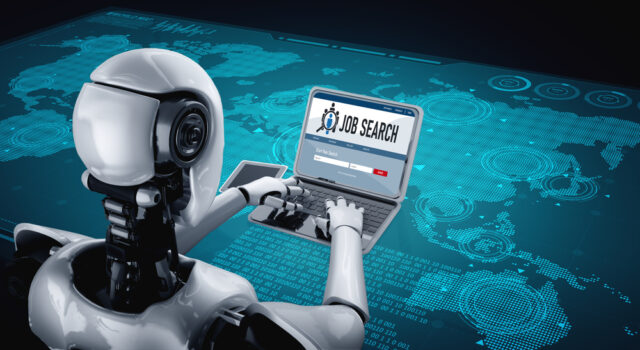Is artificial intelligence about to steal your job? [Q&A]

With artificial intelligence becoming more powerful and completing more complex tasks, the natural question being asked in the industry is if and when AI will steal human jobs.
Myths abound about AI working autonomously and eliminating the human workforce, starting with entry-level jobs. In reality, however, AI makes workers better and it works best when paired with humans -- their strategic thinking, specialized judgment, and adaptability remain irreplaceable.
We talked to Ambuj Kumar, co-founder and CEO of Simbian, to discuss the impact of AI and how it interacts with humans.
BN: Is AI a job stealer? If so, when will we see this happen?
AK: Artificial intelligence is not a sci-fi replacement for humans. There are many use cases and benefits of AI spanning across industries and vertical markets. For example, in cybersecurity an AI SOC (Security Operations Center) Agent is a machine learning-powered tool that triages alerts, investigates incidents, frees up humans from mundane tasks, and responds to threats like a tireless junior analyst working around the clock at machine speed. But for the best results, AI still operates under human control.
While powerful and offering important advantages, AI agents are still limited when it comes to human-driven behavior. Use case examples of what AI does excel at include automating routine tasks. In the security realm, for example, AI can screen the majority of threat alerts for human analysts, and reduce false positives by well over 50 percent by investigating and responding. AI can also significantly accelerate response times, typically resolving routine cases in a fraction of the time versus manual human intervention.
BN: What are some myths about how AI will take over human jobs, and what is reality?
AK: While AI and humans are not an OR but an AND opportunity, it’s important to address some myths buzzing around about AI. For example:
- Myth 1: AI Will Eliminate Entry-Level Jobs -- Actually, AI creates higher-value roles. In the SOC use case, with AI analysts can shift from alert janitors to cyber investigators, with salaries rising more than 20 percent for AI-savvy pros (ISC²).
- Myth 2: AI Operates Autonomously -- That’s rarely true. Due to the complex landscape of AI, it is important to know the essential role of human oversight. Especially as advanced algorithms and machine learning models continue to evolve and flood the enterprise, human guidance becomes crucial to ensure that AI systems operate safely, ethically, and effectively. This oversight helps mitigate risks and enhances the decision-making processes that shape our interactions with technology, creating better outcomes for organizations.
- Myth 3: AI Understands Your Business Context -- OK, this is only partially true. AI doesn’t know your business context all by itself, just like a new employee doesn’t know the business context…yet. The humans who supervise the AI are the ones who know if a server outage affects $10M in sales or just the office’s local machine. But if they pass that knowledge to the AI tool, the AI can apply that learning at scale.
BN: How can humans expect to interact, and exist, with AI?
AK: There’s no stopping AI in organizations, that’s clear. When it comes to the SOC for example, Gartner agrees. Its industry analysts predict that 75 percent of SOCs will deploy AI agents by 2026. But it’s not a question of humans or machines – the future is humans empowered by machines. The most effective model for the use of AI in organizations is a hybrid human-AI model.
Not only does AI make employees more powerful and better at their jobs, but the AI-adopting organization of the future has the opportunity to create even more positions. For example, in cybersecurity AI trainers are needed to help AI tools learn and fine-tune models to reduce false positives. In addition, incident commanders will be employed in future SOCs to lead breach response with AI-generated playbooks. And new positions will open for threat hunters who using AI will proactively search for adversaries in cloud and IoT environments.
BN: What are some best practices for implementing AI to work with humans to ensure the best outcomes?
AK: As organizations continue to embrace the benefits of AI agents, they should follow these three best practices to prepare for the coming AI era and humans working with AI for the best outcomes:
- Upskill Strategically -- Train employees in AI model management (e.g., bias detection). It’s important to certify teams in hybrid frameworks -- on the cybersecurity side there’s NIST’s AI Risk Management for example.
- Start Small -- It is recommended to deploy AI for non-critical tasks first. Collecting feedback to audit AI decisions on a regular weekly basis is a good start.
- Measure What Matters -- Remember to track what matters most, on the cybersecurity side an organization might aim for a 50 percent+ reduction in Tier-1 escalations as its use of AI grows. Calculating ROI will help gain executive and organizational sponsorship and support.
BN: AI in cybersecurity is critical as cyber requires 24x7x365 100 percent attention. How can humans compete with AI threats?
AK: The impact of AI on cybersecurity is becoming increasingly important as AI continues to evolve for enterprise use. While it’s well documented how attackers are using AI for their nefarious activities, SOCs are seeing a surge in AI-powered tools aimed at detecting threats, automating responses, and streamlining incident management.
According to IBM, SOCs that embrace AI Agents this year will reduce breach costs by 40 percent. AI helps retain talent by significantly reducing burnout rates. And organizations embracing the AI SOC will outpace cybercriminals already known to be using AI for their attacks with AI-driven threat intelligence. But while AI offers 24x7 coverage, speed and efficiency, it works best when paired with humans -- human strategic thinking, specialized judgment, and adaptability remain irreplaceable. The question isn’t if AI will transform your organization -- it’s how soon will you harness its power?
Image credit: BiancoBlue/depositphotos.com
